INDIFFERENCE CURVE ANALYSIS
The concept of Indifference Curve Analysis was first propounded by British economist Francis Ysidro Edgeworth and was put into use by Italian economist Vilfredo Pareto during the early 20th century. However, it was brought into extensive use by economists J.R. Hicks and R.G.D Allen.
Hicks and Allen criticized Marshallian cardinal approach of utility and developed indifference curve theory of consumer’s demand. Thus, this theory is also known as ordinal approach.
INDIFFERENCE CURVE
An indifference curve is a locus of all combinations of two goods which yield the same level of satisfaction (utility) to the consumers.
Since any combination of the two goods on an indifference curve gives equal level of satisfaction, the consumer is indifferent to any combination he consumes. Thus, an indifference curve is also known as ‘equal satisfaction curve’ or ‘iso-utility curve’.
ACCORDING TO WATSON
“An indifference schedule is a list of combinations of two commodities the list being so arranged that a consumer is indifferent to the combinations, preferring none of any other.”
ACCORDING TO KOUTSOYIANNIS
“An indifference curve is locus of points particular of combination of good which yields the same utility to the consumer, so that he is indifferent as to particular combination he consumed.”
ACCORDING TO LEFTWITCH
“A single indifference curve shows the different combinations of X and Y that yields equal satisfaction to the consumer.”
ACCORDING TO FERGUSON
“An indifference curve is a combination of goods, each of which yields same level of utility to which the consumer is indifferent.”
ACCORDING TO PROF. J.M. JOSHI
“An indifference curve is a locus of points which are geometrical representations of combination of commodities (X and Y) such that the consumer is indifferent among any of these combinations.”
ACCORDING TO PROF. J.K. SMITH
“It is locus of the points representing pairs of quantities between which the individual is indifferent, so it is termed as indifference curve.”
ACCORDING TO PROF. HENDERSON AND PROF. QUANDT
“The locus of all commodity combinations from which a consumer derives the same level of satisfaction forms an indifference curve.”
The Indifference Curve shows the different combinations of two goods that give equal satisfaction and utility to the consumers. In other words, the indifference curve is the graphical representation of different combinations of goods (generally two), for which the consumers are indifferent, in terms of the overall satisfaction and the utility.
INDIFFERENCE SCHEDULE
An indifference schedule is a list of combination of two commodities, the list being so arranged that a consumer is indifferent to the combinations, preferring none of them to any of other. Thus, an indifference schedule may be defined as a schedule of various combinations of two goods that will be equally acceptable to the consumer.
The table given below is an example of indifference schedule and the graph that follows is the illustration of that schedule.
| Combination | Mangoes | Oranges |
| A | 1 | 14 |
| B | 2 | 9 |
| C | 3 | 6 |
| D | 4 | 4 |
| E | 5 | 2.5 |
Graphical representation of indifference curve
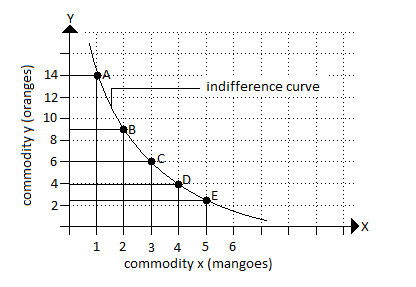
INDIFFERENCE MAP
The Indifference Map is the graphical representation of two or more indifference curves showing the several combinations of different quantities of commodities, which consumer consumes, given his income and the market price of goods and services.
The consumer preferences give rise to several combinations of commodities, each yielding the same level of satisfaction. Hence, it is critical to understand the preferences of the consumer as these vary from individual to individual and market to market. The concept of the indifference map can be further understood through a figure given below:

The space between axis X and Y is called as the Indifference Plane or Commodity Space. This plane is comprised of finite points, each point representing the different combinations of goods X and Y. It is possible to identify two or more points on the indifference plane, which shows different combinations of good X and Y, yielding the same level of utility.
Thus, it is always possible to draw a number of indifference curves without intersecting or being tangent to each other. These indifference curves Viz. IC1, IC2, IC3, IC4, drawn graphically represents the indifference map. Thus, an indifference map may contain several IC curves positioned on the basis of the consumer’s preferences.
MARGINAL RATE OF SUBSTITUTION
The marginal rate of substitution (MRS) can be defined as how many units of good x have to be given up in order to gain an extra unit of good y, while keeping the same level of utility. Therefore, it involves the trade-offs of goods, in order to change the allocation of bundles of goods while maintaining the same level of satisfaction. It can be determined using the following formula:
(MRSxy) = ∆Y/ ∆X
The Marginal Rate of Substitution is used to analyze the indifference curve. This is because the slope of an indifference curve is the MRS.
BUDGET LINE
A budget line is a straight line that slopes downwards and consists of all the possible combinations of the two goods which a consumer can buy at a given market price by allocating all his/her income. It is an entirely different concept from that of an indifference curve, though they are both are essential for consumer equilibrium.
The two essential components of a budget line are:
- The purchasing power of a consumer, i.e. his/her income;
- The market price of both commodities.
The budget line is shown as below:
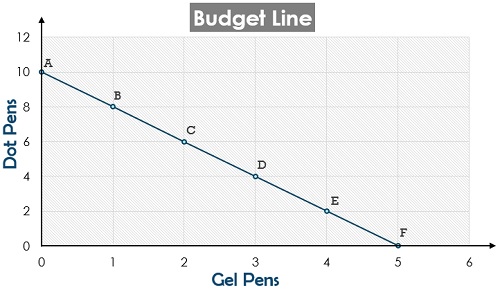
ASSUMPTIONS OF INDIFFERENCE CURVE ANALYSIS
Indifference curves analysis is based upon some assumptions, which determine its strength, applicability and shortcomings. W.J. Baumol has taken three main assumptions of non-satiety, transitivity and diminishing marginal rate of substitution.
The various assumptions of the analysis are explained below.
CONSISTENCIES
It is assumed that the consumer is consistent in his choice, i.e. if in one period he chooses commodity A over B; then he will not choose B over A in another period if both the commodities are available in the same amount. This condition simply requires that the consumers tastes possess a conceptually simple type of consistency.
PERFECT KNOWLEDGE
A consumer is assumed to have complete knowledge regarding the types of goods available, their prices and their capacity to satisfy a want. He is also assumed to know his income during his consumption- planning period.
TWO GOODS
It is assumed that consumer has a fixed amount of money whole of which is to be spent on the two goods, given constant prices of both the goods. This is a very restrictive assumption, because, in reality, the consumer deals with a large number of commodities. This restrictive assumption is made to facilitate graphic representation of indifference curves.
TASTES AND PREFERENCES
The tastes and preferences of consumer do not change.
TRANSITIVITY
It is assumed that consumer’s choices are characterised by transitivity and consistency. Given three commodities bundles ‘A’, ‘B’, and ‘C’, if a consumer prefers ‘B’ to ‘A’ and ‘C’ to ‘B’, he will definitely prefers ‘C’ to ‘A’.
That is, if B > A, C > B, then C > A. Similarly, if the consumer is indifferent between ‘A’ and ‘B’, ‘B’ and ‘C\ then he will be indifferent between ‘A’ and ‘C’. The consistency assumption implies well defined preferences, that is, if A< B, then B > A.
NON SATIETY
Satiety means saturation. And, indifference curve theory assumes that the consumer has not reached the point of satiety. It implies that the consumer still has the willingness to consume more of both the goods. The consumer always tends to move to a higher indifference curve seeking for higher satisfaction.
DIMINISHING MARGINAL RATE OF SUBSTITUTION
Marginal rate of substitution may be defined as the amount of a commodity that a consumer is willing to trade off for another commodity, as long as the second commodity provides same level of utility as the first one.
And, diminishing marginal rate of substitution states that the rate by which a person substitutes X for Y diminishes more and more with each successive substitution of X for Y.
As indifference curve theory is based on the concept of diminishing marginal rate of substitution, an indifference curve is convex to the origin.
RATIONALITY
Consumer is assumed to be rational. He aims to maximise the total satisfaction, given his income and market prices. He is also assumed to have full knowledge of market conditions. Further, he is consistent in his choice, i.e., if in one situation he chooses combination ‘A’ rather than combination ‘B’ he will not choose ‘B’ in preference to ‘A’ in another situation.
DIVISIBILITY
The commodities are assumed to be divisible. This means that quantities of commodities can be increased (or decreased) in minute amounts and the corresponding changes in total satisfaction can also be very small. This assumption makes indifference curve continuous without gaps or breaks.
POSITIVE MARGINAL UTILITIES
The goods (or commodities) are considered good and have positive marginal utilities. This implies that given any combination of two commodities, increase in quantity of one commodity increases the total satisfaction and vice-versa. Therefore, in order to keep the total utility at the same level, the quantity of one commodity should be increased for every reduction in the quantity of other commodity.
ORDINAL UTILITY
Utility can be measured only in ordinal terms and not cardinal ones. In other words, consumer cannot measure precisely utility or satisfaction in absolute units. He can conveniently arrange various combinations of two or more goods in ascending or descending order of preference. Between any two combinations, he is only able to tell that utility from one combination is more than, equal to, or less than the utility from the other combination. He is not in a position to tell as to the amount of difference in the utility from any two combinations.
COMPLETENESS
To enable the consumer to make an optimal choice in the commodity space (entire area lying between the X-axis and Y-axis, it is assumed that between any two bundles, either the consumer is indifferent or one is preferred to other. Thus, every commodity bundle will lie on some indifference curve.
PROPERTIES OF INDIFFERENCE CURVE
DOWNWARD SLOPING
An indifference curve slope downward, which means, that with the more consumption of one good the consumption of the other is to be reduced to maintain the utility.Here, the principle of the marginal rate of substitution (MRS) applies, which means the increased consumption of one commodity is to be set off by the reduced consumption of another commodity, so as to have the same level of satisfaction or utility. Thus, the indifference curve is negatively sloped.
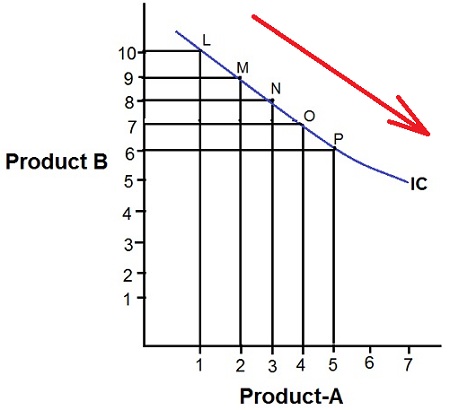
CONVEX TO THE ORIGIN
The indifference curves are convex to the origin because of the diminishing marginal rate of substitution. The MRS diminishes because of the decline in the marginal utility, which means with more and more consumption of one commodity, the customer’s utility starts declining and he is not willing to consume it more at the cost of the other commodity.
For example, let’s say there are two commodities, coffee and cigarattes, with more and more consumption of coffee, the utility continues to decline, and the customer will no more give up the cigarettes to buy the coffee. Here, MRS shows the slope of the indifference curve.
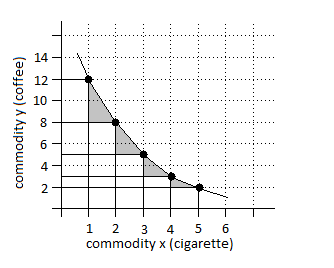
HIGHER THE INDIFFERENCE CURVE, THE HIGHER IS THE LEVEL OF SATISFACTION
The consumer derives more satisfaction from the combination of two goods on a higher indifference curve because more units of both the commodities are used that will surely be more satisfying than the lower quantity combinations.
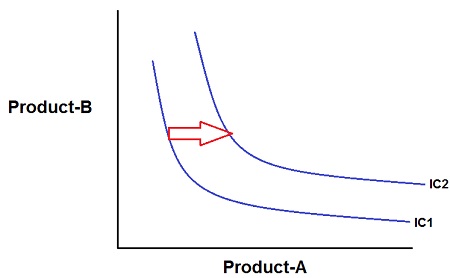
CANNOT INTERSECT OR BE TANGENT TO EACH OTHER
The indifference curves cannot intersect with each other, because if it does so, then the combinations of two commodities lying on two different curves will yield the same level of satisfaction which is not correct.
Thus, it is clear from the properties of the indifference curve that the customer realizes an equal satisfaction and the utility from the use of different combinations of two commodities.
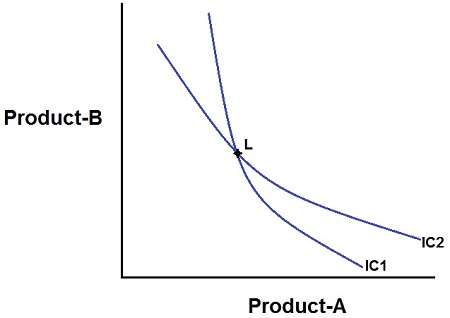
INDIFFERENCE CURVE DO NOT TOUCH HORIZONTAL OR VERTICAL AXIS
One of the basic assumptions of indifference curves is that the consumer purchases combinations of different commodities. He is not supposed to purchase only one commodity. In that case indifference curve will touch one axis. This violates the basic assumption of indifference curves.
In the above diagram, it is shown that the in difference IC touches Y axis at point P and X axis at point S. At point C, the consumer purchase only OP commodity of Y good and no commodity of X good, similarly at point S, he buys OS quantity of X good and no amount of Y good. Such indifference curves are against our basic assumption. Our basic assumption is that the consumer buys two goods in combination.
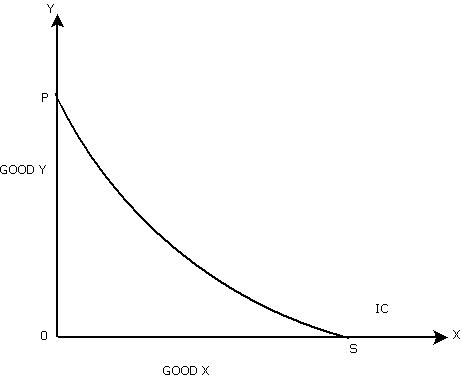
INDIFFERENCE CURVES ARE NOT NECESSARILY PARALLEL TO EACH OTHER
Though they are falling, negatively inclined to the right, yet the rate of fall will not be the same for all indifference curves. In other words, the diminishing marginal rate of substitution between the two goods is essentially not the same in the case of all indifference schedules. The two curves I1and I2 shown in figure are not parallel to each other.
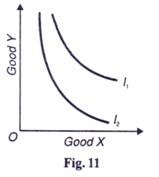
PERFECT COMPLEMENTARY GOODS HAVE L-SHAPED INDIFFERENCE CURVES
In case of those complementary goods which are jointly demanded like bread and butter, shoes and socks, etc., the indifference curves will be L-shaped as given in Diagram.
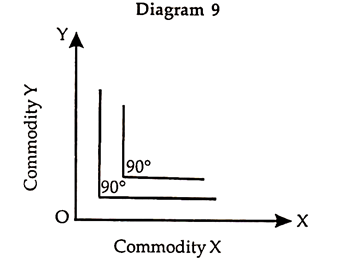
The diagram depicts that two perfect complementary goods will have L-shaped indifference curves and they will be parallel to OX-axis and OY-axis joining each other at 90°.
UTILITY OF INDIFFERENCE CURVE ANALYSIS
PROBLEM OF EXCHANGE
With the indifference curve method the problem of exchange amidst two individuals can be conversed. We take two consumers A and B in fixed amount correspondingly. The problem is how they can exchange the commodities obsessed by each other. This can be unravelled by building an EdgeWorth Bowley box figure on the basis of their choice maps.
EFFECTS OF SUBSIDY ON CONSUMERS
The indifference Curve method can be used to gauge the effects of government subsidy on low earnings groups. We take a condition when the subsidy is not paid in money but the consumers are supplied cereals at dispensation rates the price difference being paid by the government.
THE PROBLEM OF RATIONING
The indifference curve method is used to make clear the problem arising from diverse systems of rationing. Usually rationing comprises of setting specific and equal quantities of commodities to each individual. The other, rather liberal scheme is to allow an individual more or less quantities of the rationed commodities according to his liking. It can be demonstrated with the help of indifference curve study that the last scheme is definitely better and beneficial than the former.
INDEX NUMBERS: MEASURING COST OF LIVING
The indifference curve study is used in measuring the cost of living or standard of living in terms of index numbers. We come to identify with the help of index numbers whether the consumer is better off or worse off by matching two time periods when the earnings of the consumer and prices of two commodities vary.
EARNINGS LEISURE TRADE-OFF AND SUPPLY OF LABOUR
A worker’s offer to supply his labour depends on his choices amidst earnings and leisure and the wage rate. Earnings and leisure are inversely allied, whereas there is a direct affiliation amidst earnings and hours per day. Leisure is always exchange for earnings. The supply curve of an individual worker can also be derived with the indifference curve method. His offer to supply labour depends on his choice amidst earnings and wage rate.
EFFECT OF EARNINGS TAX VS. EXCISE DUTY
The indifference curve method in considering the benefit allegations of earnings tax vs. excise duty is sales tax. The question is whether an earnings tax hurts the tax payer more or an excise duty of an equal amount. In actual, the earnings tax is equivalent to an excise duty places the tax payer in a favourable position.
THE SAVING PLAN OF AN INDIVIDUAL
The indifference curve method can also be used to study the saving plan of an individual. An individual’s choice to save depends upon his present and future earnings, his likings and choices for present and future commodities, their expected prices on current and future rate of interest and on the stock of his savings. As a matter of decision to save is influenced by the intensity of his desire for present commodities and future commodities.
CRITICISM OF INDIFFERENCE CURVE ANALYSIS
There are a variety of uses of indifference curve analysis. It is superior to utility analysis based on cardinal approach. However, the analysis has its limitations.
It has been criticised on various grounds as given below:
BASED ON UNREALISTIC MODEL OF TWO GOODS
The indifference curve analysis is based on two commodity model. As we see in practice that consumers have unlimited wants and for the satisfaction of their wants they consume more than two goods. The analysis is based on two goods model which is unrealistic and we cannot study more than two goods with the help of the indifference curves. Geometrical technique can study more than two goods and algebra has to be used which is complicated one.
IRRATIONALITY OF CONSUMER
The indifference curve analysis also assumes that each individual consumer is a rational human being and he behaves accordingly. But in real practice we see that consumer is not a rational human being. He is not only affected by economic variable but he is also affected by non-economic variables, namely, climatic condition, region, social custom, caste, language and region while taking the decisions.
OLD WINE IN A NEW BOTTLE
Indifference curve analysis is nothing but an old wine in a new bottle. It has retained the same assumption of utility analysis as propounded by Marshall. It has given concepts but there is not basic difference between utility analysis and indifference curve analysis. It has taken to ordinal numbers, namely, I, II and III in place of cardinal numbers, namely, 1, 2, and 3. There is no basic difference between the two.
It has taken the diminishing marginal rate of substitution in place of law of diminishing marginal utility (MUx/MUy = MRSxy). It has presented indifference curve analysis in the new form which is just like the utility analysis.
BASED ON UNREALISTIC ASSUMPTIONS
Indifference curve analysis is based on unrealistic assumptions. It assumes that the consumer is well aware of his preferences or he knows the indifference map. In practice we see that a consumer even does not know the various combinations of two commodities giving the same level of satisfaction. He is not aware of his indifference map.
Sometimes the combinations of two goods are also not realistic which are far from the real practice. For example, 2 pairs of shoes and 4 pairs of shirts or 4 pairs of shoes and 2 pairs of shirts will give the same level of satisfaction. It is not realistic and practical.
BASED ON INDIVIDUAL BEHAVIOUR AND EQUILIBRIUM
Indifference curve analysis is based on individual behaviour and equilibrium. It cannot be used to study the group behaviour of consumers and their equilibrium showing the different levels of satisfaction with different combinations of two goods.
COMPLICATED ANALYSIS
Indifference curve analysis is not an easy analysis. Utility analysis is easy to understand, but indifference curve analysis is complicated one. We cannot segregate income effect and substitution effect from price effect. At the same time, derivation of demand curve with the help of indifference curve is also not an easy task.
FAILS TO STUDY OBSERVED BEHAVIOUR OF THE CONSUMER
Indifference curve analysis fails to study the observed behaviour of an individual consumer in the market. The collection of data relating to scale of preferences of an individual consumer behaviour are not easily available and their collection is also very difficult. Indifference curves are also imaginary and the consumer behaviour cannot be studied well.
SHORT RUN STUDY OF CONSUMER’S PREFERENCES
Indifference curve analysis studies the consumer’s preferences during short period. Consumer’s behaviour goes on changing over a long period of time and it is affected by several factors. This type of study of consumer behaviour is not possible with the help of indifference curve analysis.
IGNORANCE TOWARDS DEMONSTRATION EFFECT
The demonstration effect states that an individual’s consumption pattern is affected by the level of consumption of other individuals. This is ignored by IC analysis limiting its use to understand consumer behaviour.
Thus, we can say that indifference curve analysis has given a new technique of studying economic analysis and its applications to various parts of economics. It studies consumer behaviour in a different manner than that of marshallian utility analysis.
